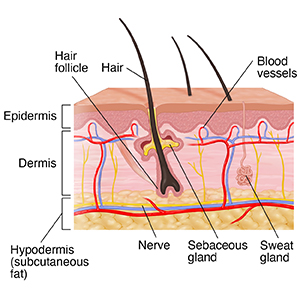A
B
C
D
E
F
G
H
I
J
K
L
M
N
O
P
Q
R
S
T
U
V
W
X
Y
Z
Topic IndexLibrary Index
Click a letter to see a list of conditions beginning with that letter.
Click 'Topic Index' to return to the index for the current topic.
Click 'Library Index' to return to the listing of all topics.
Anatomy of the Skin
Facts about the skin
The skin is the body's largest organ. It covers the entire body. It serves as a protective shield against heat, light, injury, and infection. The skin also:
-
Regulates body temperature.
-
Stores water and fat.
-
Is a sensory organ.
-
Prevents water loss.
-
Prevents entry of bacteria.
-
Acts as a barrier between the body and its environment.
-
Helps to make vitamin D when exposed to the sun.
Your skin takes on different thickness, color, and texture all over your body. For example, your head contains more hair follicles than anywhere else. But the soles of your feet have none. And the soles of your feet and the palms of your hands are much thicker than skin on other areas of your body.

The skin is made up of three layers, called the:
Each layer has certain functions.
|
Layer
|
What it does
|
|
Epidermis
|
The epidermis is the thin outer layer of the skin. It consists of two primary types of cells:
-
Keratinocytes. These cells make up about 90% of the epidermis and are responsible for its structure and barrier functions.
-
Melanocytes. These cells are found at the base of the epidermis and make melanin. This gives the skin its color.
|
|
Dermis
|
The dermis is the middle layer of the skin. The dermis contains:
The dermis is held together by a protein called collagen. This layer gives skin flexibility and strength.
|
|
Subcutaneous fat layer
|
The subcutaneous fat layer is the deepest layer of skin. It's made of a network of collagen and fat cells. It helps conserve the body's heat and protects the body from injury by acting as a shock absorber.
|
Online Medical Reviewer:
Daphne Pierce-Smith RN MSN
Online Medical Reviewer:
Janet Campbell RN BSN
Online Medical Reviewer:
Tara Novick BSN MSN
Date Last Reviewed:
9/1/2025
© 2000-2025 The StayWell Company, LLC. All rights reserved. This information is not intended as a substitute for professional medical care. Always follow your healthcare professional's instructions.